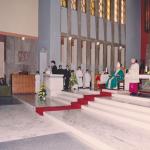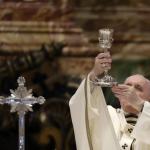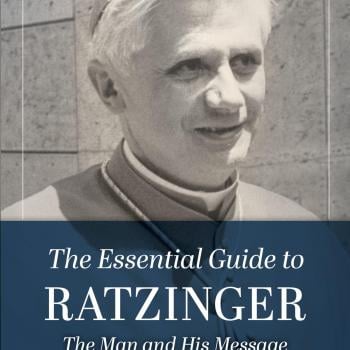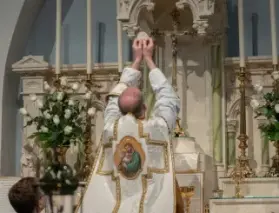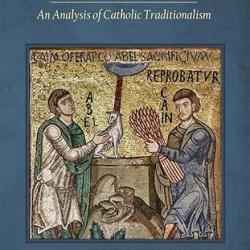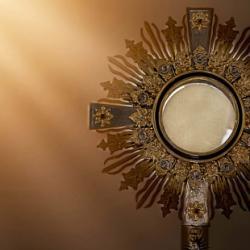Part IV: Pope Benedict XVI’s Liturgical Vision: Summorum Pontificum and Beyond
Editor’s note: This is the fourth article in a series by Andrew Likoudis entitled “The Liturgical Reform – Council, Consilium, and Papacy.” Click here for Part 1: “The liturgical path of the Church after Vatican II.” Click here for Part 2: “The Post-Conciliar Era: The Church and the rise of traditionalism.” Click here for Part 3: “John Paul II and the Liturgical Reforms.”
Pope Benedict XVI’s pontificate (2005-2013) was characterized by a deep commitment to the liturgical heritage of the Church. Recognizing the ongoing debates and divisions within the Church regarding liturgy, Benedict sought to harmonize the post-conciliar liturgical reforms with a renewed appreciation for the Church’s traditional liturgical expressions.
Though his pontificate saw very few changes to the reformed liturgy, his writing before ascending to the Chair of Peter was prolific, and sheds light on his thoughts about the reform.
As a Cardinal and theologian, he wrote in 1987:
Lest there be any misunderstanding, let me add that as far as its content is concerned (apart from a few criticisms), I am very grateful for the new Missal, for the way it has enriched the treasury of prayers and prefaces, for the new Eucharistic Prayers and the increased number of texts for use on weekdays, and so on, quite apart from the availability of the vernacular. But I do regard it as unfortunate that we have been presented with the idea of a new book rather than with that of continuity within a single liturgical history. In my view, a new edition will need to make it quite clear that the so-called Missal of Paul VI is nothing other than a renewed form of the same Missal to which Pius X, Urban VIII, Pius V, and their predecessors have contributed, right from the Church’s earliest history. It is of the very essence of the Church that she should be aware of her unbroken continuity throughout the history of faith, expressed in an ever-present unity of prayer. This awareness of continuity is destroyed just as much by those who “Opt” for a book supposed to have been produced four hundred years ago as by those who would like to be forever drawing up new liturgies. At bottom, these two attitudes are identical. … The fundamental issue is whether faith comes about through regulations and learned research or through the living history of a Church that retains her identity throughout the centuries.[1]
He later wrote in 1992, in the preface of Monsignor Klaus Gamber’s The Reform of the Roman Liturgy,
A young priest recently said to me: “Today we need a new liturgical movement.”… He felt that we needed a new beginning from within the liturgy, as the liturgical movement had wanted when it was at the height of its true nature, when it was not a matter of fabricating texts, inventing actions and forms, but of rediscovering the living center, of penetrating the very fabric of the liturgy, so that the fulfillment of the liturgy would come from its very substance.
The liturgical reform, in its concrete realization, has moved ever further away from this origin. … On the one hand, we have a liturgy that has degenerated into a show, in which people try to make religion interesting by means of fashionable nonsense. … On the other hand, there is the conservation of ritual forms whose greatness is always impressive, but which, pushed to the extreme, manifests an obstinate isolation and finally leaves only sadness.
Certainly, between the two there remain all those priests and their parishioners who celebrate the new liturgy with respect and solemnity; but they are called into question by the contradiction between the two extremes, and the lack of internal unity in the Church finally makes their fidelity seem (wrongly for many of them) to be merely a personal variety of neo-conservatism. Because this is so, a new spiritual impulse is needed to make the liturgy once again a communal activity of the Church for us and to remove it from the arbitrariness of parish priests and their liturgy committees.
Theological Underpinnings
As Cardinal Ratzinger, he would write again, this time critiquing the pre-conciliar liturgical theology and also in reference to the Liturgical Movement who formed the ground of the Council’s renewed theology:
What mattered in the sacraments, and likewise in the Eucharist, was essentially their validity and, therefore, the moment of Consecration. Eucharistic theology had been reduced to an ontological and juridical problem, everything else being considered as beautiful ceremonies, interesting, and capable or incapable of interpretation in an allegorical sense, but not as the reality in which the Eucharist has its concrete existence. It was thus necessary to discover anew that the liturgy is not just a collection of ceremonies that aim to give length and solemnity to the Consecration, but that this is the world of the sacrament as such. This was a new vision, and in that sense they went beyond a narrow kind of theology and discovered a more profound vision, not only of theology, but of the whole Christian life. We can grasp the stature of the Liturgical Movement only in the historical context of an understanding of the liturgy that was severely lacking. For example, from the time of Leo XIII on, we used to recite the Rosary during Mass all through October-and that was still the custom when I was young. The Mass was thus truly, as I wrote in the preface to my book, like a painted-over fresco. Thus, to rediscover that the liturgy in itself is living and is a reality experienced by the Church as such was a development that considerably enriched the Church. We have therefore left far behind those misunderstandings, those inadequate conceptions and deficient visions of the liturgy and of theology. I even think, too, that the explosive outbreak of the Reformation in the sixteenth century was possible because there was no longer any real understanding of the liturgy. For Luther, all that remained of the Mass was the Consecration and the distribution of Holy Communion.[2]
The Problem of Roman Rites within the Roman Rite
This did not mean however, that he agreed with the Pope St. Paul VI’s initial decision to derogate (not abrogate) the preconciliar Missal. In fact, like Pope St. John Paul II, he supported the expanded use of this missal, though for different reasons. Whereas Pope St. John Paul II authorized expanded use of the 1962 Missal primarily in order to reconcile the Lefebvrites and other traditionalists, Benedict, though affirming this value, saw another benefit in the continued (and expanded) use of the older Missal lying also in the continuity it pointed toward. He writes:
Personally, from the beginning I was in favor of the freedom to continue using the old Missal, for a very simple reason: people were already beginning to talk about making a break with the preconciliar Church and of developing various models of Church—a preconciliar and obsolete type of Church and a new and conciliar type of Church.
… It seems to me essential, the basic step, to recognize that both Missals are Missals of the Church and belong to the Church, which remains the same as ever. … It seems to me indispensable to continue to offer the opportunity to celebrate according to the old Missal, as a sign of the enduring identity of the Church.
[T]he old Missal is a point of reference, a criterion—as [Professor Spaemann] said, a semaphore signal. … [T]his Missal of the Church should offer a point of reference and should become a refuge for those faithful who, in their own parish, no longer find a liturgy genuinely celebrated in accordance with the texts authorized by the Church. …One problem, on the other hand, does remain: How are we to regulate the use of the two rites? To me it seems clear that, in law, the Missal of Paul VI is the Missal in current use and that using it is normal (or normative). We should therefore consider how to permit the use of the old Missal, and to preserve this treasure for the Church. … Yet there is a very real problem here: if the ecclesial community becomes a matter of free choice, if there are, within the Church, ritual churches, chosen according to subjective criteria, that does create a problem. The Church is built on the bishops, in keeping with apostolic succession, in the form of local Churches, therefore with an objective criterion. I am in this local Church, and I do not look for my friends there, I find my brothers and my sisters; and these brothers and sisters are not people we look for, we just find them there. This situation of the non-arbitrariness of the Church in which I find myself, which is not a church of my choice but rather the Church that presents itself to me, is a very important principle. … I am in the common Church, along with the poor, the wealthy, with people I like and people I do not like, with intellectuals and uneducated people; I am in the Church, which was there before me. Opening up the opportunity of choosing one’s Church “à la carte” is something that could genuinely damage the structure of the Church.
One ought, therefore it seems to me to look for a non-subjective criterion with which to open up the opportunity of using the old Missal … and preserve this treasure for all the faithful; yet, on the other hand, it must also preserve and respect the episcopal structure of the Church.[3]
Summorum Pontificum (2007): An Attempt at Mutual Enrichment
In 2007, only two years after his election, Benedict XVI issued the Motu Proprio Summorum Pontificum. This document was a significant change in the Church’s liturgical life, as it granted much greater freedom for the celebration of the Mass according to the 1962 Roman Missal. What was previously an allowance made for those attached to the pre-conciliar form, this new papal decision granted basically unrestricted access to the pre-conciliar form, what became known under this new legislation as the Extraordinary Form, however it did not grant the unbridled license, taken by many, to now attend the Extraordinary Form exclusively, and to reject the Ordinary Form. As Pope Benedict XVI, he writes in the Letter, Con Grande Fiducia, which accompanied this new Motu Proprio:
Needless to say, in order to experience full communion, the priests of the communities adhering to the former usage cannot, as a matter of principle, exclude celebrating according to the new books. The total exclusion of the new rite would not in fact be consistent with the recognition of its value and holiness. … It is not appropriate to speak of these two versions of the Roman Missal as if they were ‘two Rites.’ Rather, it is a matter of a twofold use of one and the same rite.
Key Provisions of Summorum Pontificum
The document, in addition to recognizing the pre-conciliar liturgy as an extra-ordinary form of the Church’s liturgy, allowed priests to celebrate it without needing specific permission from their bishops. It aimed to facilitate the access of the faithful to this form of the Mass, acknowledging its importance as a precious spiritual and cultural heritage.
The Motivation Behind the Document
Benedict XVI’s decision to issue Summorum Pontificum was multifaceted. Primarily he sought to illuminate for the faithful the liturgy’s unity of inner identity,[4] and to insist that “What earlier generations held as sacred, remains sacred and great for us too, and it cannot be all of a sudden entirely forbidden or even considered harmful.”[5]
And along with this, he saw that allowing it served to attract young people who “found in it a form of encounter with the Mystery of the Most Holy Eucharist, particularly suited to them.”[6]
And though not his primary motivation, he, like his predecessor naturally realized that such an allowance could help heal the rifts within the Church that had emerged over liturgical matters, primarily with the SSPX, and other canonically irregular or unrecognized groups. By acknowledging the value of both the ordinary (post-conciliar) and extraordinary (pre-conciliar) forms of the Mass, he sought to foster a sense of unity-in-diversity within the Church’s liturgical practice.
The “Reform of the Reform”
Pope Benedict XVI also emphasized that the two forms of the Roman Rite should be mutually enriching. This did not mean, however that he believed that the allowance for the preconciliar Missal was to be considered an absolute right. He noted again, while still Cardinal Ratzinger:
What can we do, given that the goal we are all aiming for in the end—it seems to me is liturgical reconciliation and not rigid uniformity? I am not in favor of rigid uniformity, but we should, of course, be opposed to chaos, to the fragmentation of the liturgy, and in that sense, we should also be in favor of observing unity in the use of Paul VI’s Missal.
That seems to me a problem to be faced as a priority: How can we return to a common rite, reformed (if you like) but not fragmented or left to the arbitrary devices of local congregations, or that of a few commissions or groups of experts? Thus the “reform of the reform” is something that concerns the Missal of Paul VI, always with this aim of achieving reconciliation within the Church, since for the moment there exists instead a painful opposition, and we are still a long way from reconciliation, even though these days we have shared together here are an important step toward that reconciliation.[7]
Here he further outlined some suggestions:
As for the Missal in current use, the first point, in my opinion, would be to reject false creativity. … We have recalled more than once what the Council actually said on this subject: Only the ecclesiastical authority makes decisions; neither the priest nor any group of people has the right to change the liturgy. But in the new Missal we quite often find formulae such as: sacerdos dicit sic vel simili modo … [the priest speaks thus or in a similar way …] or Hic sacerdos potest dicere … [Here the priest can say….]
These formulae of the Missal in fact give official sanction to creativity; the priest feels almost obliged to change the wording, to show that he is creative, that he is giving this liturgy immediacy, making it present for his congregation; and with this false creativity, which transforms the liturgy into a catechetical exercise for this congregation, liturgical unity and the ecclesiality of the liturgy are being destroyed.
Therefore, it seems to me, it would be an important step toward reconciliation if the Missal were simply freed from these areas of creativity, which do not correspond to the deepest level of reality, to the spirit, of the liturgy. …
The second point about which we have spoken is the translations. … There are some Congregations in the United States where, in the name of inclusive language, they no longer dare to say, “In the name of the Father, and of the Son, and of the Holy Spirit,” because that is “male chauvinism”—the Father and the Son, two men. They then say, “In the name of the Creator, of the Redeemer, and of the Holy Spirit.” That is just one example to show the seriousness of the problem. … There is a new document from the Holy See on this problem that constitutes, it seems to me, genuine progress. [Cf. Congregation for Divine Worship and the Discipline of the Sacraments, Liturgicam Authenticam, March 28, 2001.]
I would just add this: we ought also to preserve some elements of Latin in the liturgy in ordinary use; the presence of a certain amount of Latin seems to me important, as constituting a bond of ecclesial fellowship and communion.
The third problem is the celebration versus populum. As I have written in my books, I think that celebration turned toward the east, toward the Christ who is coming, is an apostolic tradition. I am not however in favor of forever changing churches around completely. … But if there were always, on every altar, a cross, a quite visible cross, as a point of reference … then we would have our east, because in the end the Crucified Christ is the Christian east.
He believed that these enrichments, features already of the preconciliar liturgy, (at the time of his pontificate, the Extraordinary Form) could provide a deeper sensory/aesthetic experience of the sacred, and a more profound understanding of the Church’s liturgical heritage, while the Ordinary Form, more accessible to the average member of the faithful, offered a renewed emphasis on intelligibility by providing necessary catechesis through understandable words and symbols which corresponded better to modern man’s situation (especially since many today lack proper catechesis); increased opportunities for active participation; and further scriptural richness with expanded lectionaries and new prefaces.
Response and Impact
The response to Summorum Pontificum by the bishops, clergy, and lay faithful was mixed. While it was received with great enthusiasm by traditionalist groups and those with an attachment to the pre-conciliar Missal, others expressed concern that it might lead to further divisions within the Church or a rollback of the reforms of Vatican II. However, Benedict XVI viewed this move as a means of reconciliation and a step towards a more inclusive Church that recognizes the richness and diversity of its liturgical traditions. He stated again in the same Letter cited before, that:
The fear was expressed in discussions about the awaited Motu Proprio, that the possibility of a wider use of the 1962 Missal would lead to disarray or even divisions within parish communities. This fear also strikes me as quite unfounded.[8]
Nevertheless, Benedict instructed the bishops,
I invite you, dear Brothers, to send to the Holy See an account of your experiences, three years after this Motu Proprio has taken effect. If truly serious difficulties come to light, ways to remedy them can be sought.[9]
Discussing the Future of the Missal of St. Pius V
Pertinently, though still as Cardinal he would write—and these sentiments can also be reflected on today, in light of the abrogation of Summorum Pontificum,
I know very well the sensibilities of those faithful who love this liturgy—these are, to some extent, my own sensibilities. And in that sense, I understand quite well what Professor Spaemann was saying when he asserted that if you do not know the aim of a reform, however small it may be, if vou are left to suppose that this is just an intermediate step toward a complete revolution, then people feel sensitive about it. …
However, he did also say—and I emphasize this—that it would be fatal for the old liturgy to be, as it were, placed in a refrigerator, left like a national park, a park protected for the sake of a certain kind of people, for whom one leaves available these relics of the past. …
It must also be liturgy of the Church and under the authority of the Church; and only within this ecclesial dimension, in a fundamental relationship with the authority of the Church, can it give all that it has to offer. Naturally, one can say, “We no longer have any confidence in the authority of the Church, after all we have been through in the past thirty years.” It is nevertheless a basic Catholic principle to trust in the authority of the Church.[10]
Enhancing Liturgical Formation and Understanding
Despite little formal changes made, with the exception of Summorum Pontificum, Pope Benedict XVI’s efforts went beyond his Motu Proprio in one way at least. He consistently advocated for a deeper liturgical formation among the clergy and laity and a more profound theological understanding of the liturgy. His writings and teachings often reflected on the beauty and spiritual depth of the liturgy, encouraging a reverent and contemplative approach to liturgical celebration. For a pope who had no formal specialized liturgical training, many nevertheless consider him to be one of the greatest liturgists of their lifetime.
Legacy of Pope Benedict XVI’s Liturgical Reforms
Benedict’s liturgical vision was marked by a profound respect for tradition coupled with an understanding of the need for the Church to speak to the modern world with clarity, and in truth. His approach to the liturgy highlighted the continuity within the Church’s tradition, seeking to bridge gaps from liturgical disputes, and offer generous access to the Church’s liturgical heritage. Unfortunately, his generous (though seemingly tentative, given his caveat about possible difficulties) allowances towards the traditionalist communities were exploited, and his hoped-for “mutual enrichment” fell short.
The fallout from this exploitation would be later addressed by his successor, Pope Francis, after almost a decade of inter-ecclesial warfare by those weaponizing this generous allowance of Pope Benedict in their seeking to overturn the reform, and a decade likewise, of this successor pope’s patience and forbearance.
Part 5 can be found here: Pope Francis’ Liturgical Vision
Notes
[1] Cardinal Joseph Ratzinger, Collected Works vol. XI, San Francisco, Ignatius Press, 2014, 524-525.
[2] Cardinal Joseph Ratzinger, Collected Works, vol. XI, (San Francisco: Ignatius Press, 2014), 559-560.
[3] Cardinal Joseph Ratzinger, Collected Works, vol. XI, (San Francisco: Ignatius Press, 2014), 562–564 .
[4] Cardinal Joseph Ratzinger, Collected Works, vol. XI, (San Francisco: Ignatius Press, 2014), 524-525.
[5] Pope Benedict XVI, Con Grande Fiducia, Letter accompanying Summorum Pontificum.
[6] See the 2016 Peter Seewald interview with Pope Emeritus Benedict XVI.
[7] Cardinal Joseph Ratzinger, Collected Works, vol. XI, (San Francisco: Ignatius Press, 2014), 564–565.
[8] Pope Benedict XVI, Con Grande Fiducia.
[9] Pope Benedict XVI, Con Grande Fiducia.
[10] Cardinal Joseph Ratzinger, Collected Works, vol. XI, (San Francisco: Ignatius Press, 2014), 566–567.


